definition of culture
- 格式:ppt
- 大小:224.00 KB
- 文档页数:16
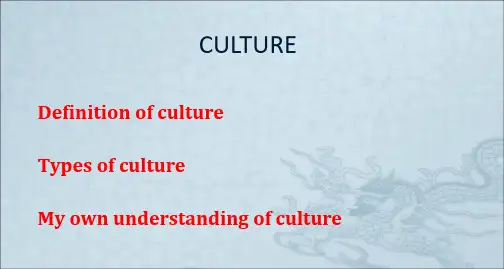
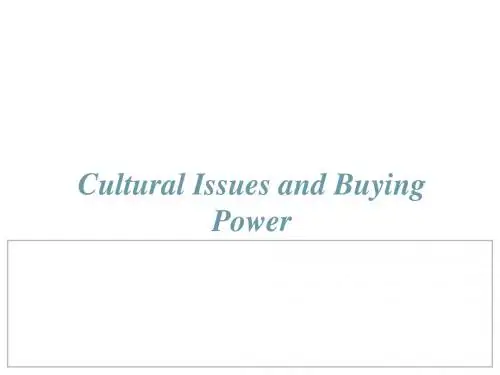
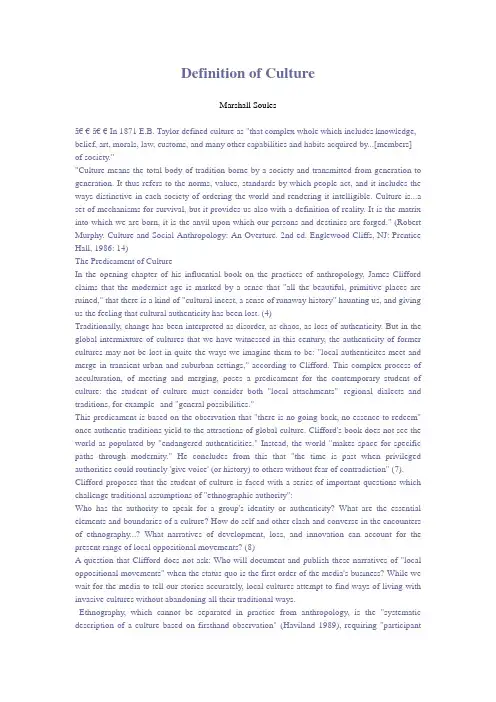
Definition of CultureMarshall Soules  In 1871 E.B. Taylor defined culture as "that complex whole which includes knowledge, belief, art, morals, law, customs, and many other capabilities and habits acquired by...[members] of society.""Culture means the total body of tradition borne by a society and transmitted from generation to generation. It thus refers to the norms, values, standards by which people act, and it includes the ways distinctive in each society of ordering the world and rendering it intelligible. Culture is...a set of mechanisms for survival, but it provides us also with a definition of reality. It is the matrix into which we are born, it is the anvil upon which our persons and destinies are forged." (Robert Murphy. Culture and Social Anthropology: An Overture. 2nd ed. Englewood Cliffs, NJ: Prentice Hall, 1986: 14)The Predicament of CultureIn the opening chapter of his influential book on the practices of anthropology, James Clifford claims that the modernist age is marked by a sense that "all the beautiful, primitive places are ruined," that there is a kind of "cultural incest, a sense of runaway history" haunting us, and giving us the feeling that cultural authenticity has been lost. (4)Traditionally, change has been interpreted as disorder, as chaos, as loss of authenticity. But in the global intermixture of cultures that we have witnessed in this century, the authenticity of former cultures may not be lost in quite the ways we imagine them to be: "local authenticites meet and merge in transient urban and suburban settings," according to Clifford. This complex process of acculturation, of meeting and merging, poses a predicament for the contemporary student of culture: the student of culture must consider both "local attachments"--regional dialects and traditions, for example--and "general possibilities."This predicament is based on the observation that "there is no going back, no essence to redeem" once authentic traditions yield to the attractions of global culture. Clifford's book does not see the world as populated by "endangered authenticities." Instead, the world "makes space for specific paths through modernity." He concludes from this that "the time is past when privileged authorities could routinely 'give voice' (or history) to others without fear of contradiction" (7). Clifford proposes that the student of culture is faced with a series of important questions which challenge traditional assumptions of "ethnographic authority":Who has the authority to speak for a group's identity or authenticity? What are the essential elements and boundaries of a culture? How do self and other clash and converse in the encounters of ethnography...? What narratives of development, loss, and innovation can account for the present range of local oppositional movements? (8)A question that Clifford does not ask: Who will document and publish these narratives of "local oppositional movements" when the status quo is the first order of the media's business? While we wait for the media to tell our stories accurately, local cultures attempt to find ways of living with invasive cultures without abandoning all their traditional ways.Ethnography, which cannot be separated in practice from anthropology, is the "systematic description of a culture based on firsthand observation" (Haviland 1989), requiring "participantobservation." For Clifford, the predicament of culture involves the difficulty of being in a culture while looking at it, "a form of personal and collective self-fashioning." (Anthropologist Ted Carpenter was fond of quoting John Culkin's remark: "We don't know who discovered water, but we're certain it wasn't a fish.") A modern ethnographer must move between cultures: "[Ethnography] is perpetually displaced, both regionally focused and broadly comparative, a form both of dwelling and of travel in a world where the two experiences are less and less distinct" (9). In The Predicament of Culture, Clifford approaches ethnographic texts as "orchestrations...constructed domains of truth, serious fictions" (10). As such, in many ways they resemble those art forms which make use of collage, juxtaposition, and other forms of extended comparison.In defining culture, then, it is important that we locate ourselves (and our beliefs, ethics, and assumptions) in relation to the culture we are studying, since culture is context-specific. It is also important to keep in mind, according to Clifford, that local cultures (sub-cultures) are often established in opposition to what might be termed the official culture--the status quo--defined by those with significant access to the media. In many cases, this opposition is between the individual, or small group, and the larger cultural body used as a sign of social cohesion and control. While popular culture is often defined as mass culture--the culture of the majority--it can also be seen as a site of continual change, adaptation, and subversion.(James Clifford, The Predicament of Culture. Cambridge, MA: Harvard UP, 1988.)Fish Out of Water"We don't know who discovered water, but we're certain it wasn't a fish."John Culkin (qtd. in Edmund Carpenter'sThey Became What They Beheld )We've been born into a world where most of what passes for reality is mediated for us. Even before television, radio, newspapers, computers, and books begin telling us stories about what is happening out there, our parents or caregivers speak to us about the perils and joys of the world. As human beings we intuit that there is something out there that exists, undeniably, apart from us and our perceptions.Who in North America doubts that media play a significant role in our lives? Think of politics, commerce, education, recreation, art and culture, or social interaction--it would be difficult, if not impossible, to discuss any of these activities without some acknowledgement of the medium through which we "know" about these things.We are inundated by messages speaking about technological determinism: the belief that technology must be adopted as it becomes available if we are to evolve as a species (or at least as a global corporate culture!). Where are the perceptive critics of the media who can balance this wave of technological promotion on the one hand, with the cynicism of the common people on the other? The real test for a student of the media is to find the middle path--the path free of ideology and rhetoric, at the mid-point between a technological utopia and the irrational fear of technological change--to arrive at a clear-eyed and knowledgeable assessment of the way we communicate with one another.We're on the edge of the (former) empire, and that gives us a certain vantage point. The Canadian media theorist Harold Adams Innis created a philosophical niche for the media analyst who lives on the margins of powerful nations. Along with his disciple, Marshall McLuhan, Innis established strategies for investigating both the medium and the message. We need a model for investigatingthe media which provides a perspective, a place to stand, without removing us too far from the centre of the action. Like the fish in water, we are so immersed in our (mediated) environment we forget it's even there.。
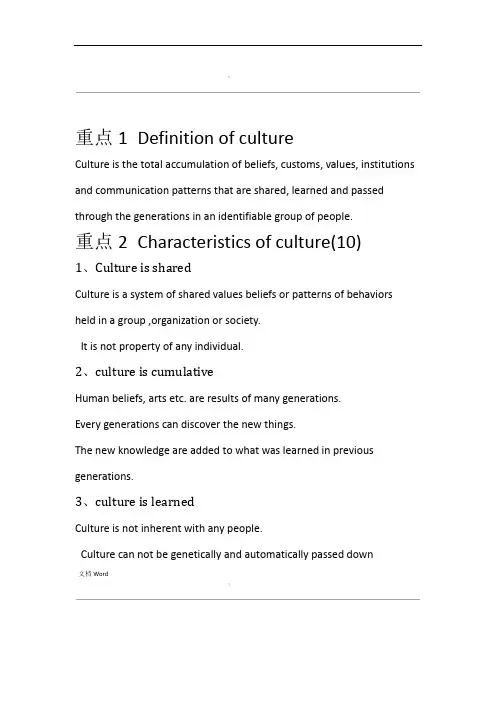
`重点1Definition of cultureCulture is the total accumulation of beliefs, customs, values, institutions and communication patterns that are shared, learned and passed through the generations in an identifiable group of people.重点2Characteristics of culture(10)1、Culture is sharedCulture is a system of shared values beliefs or patterns of behaviors held in a group ,organization or society.It is not property of any individual.2、culture is cumulativeHuman beliefs, arts etc. are results of many generations.Every generations can discover the new things.The new knowledge are added to what was learned in previous generations.3、culture is learnedCulture is not inherent with any people.Culture can not be genetically and automatically passed down文档Word`from previous generations.And it should be taught and learned by people.4、culture is adaptiveCulture is created by humans. Humans have to adapt the environment . thus is in development bears the trait of being adaptive 5、culture is dynamicAt the same time that new culture are added, and the old ones are lost because they are no longer useful.6、culture is symbolicSymbols generally serve as communicative tools for a multitude purposes, on a persons as well as culture level.7 、culture is relationalCulture is an organic whole. All the components of culture are interlinked.8 、culture is implicit and explicitSome layers culture are easy to be observe, like eating , dressing, talking. But the ideas underlying the behaviors are generally hard to know. Many scholars label the culture as iceberg.文档Word`culture is universal 9、culture is diversified、10Hall's dimensions3重点High contextHigh-context communication relies heavily on nonverbal, contextual and shared cultural meanings.The meanings are not fully expressed.re determined by “how”things are said , rather than “what”Meanings ais said.阿拉伯欧洲东部和南部日本CollectivismLow contextVerbal codes rather than the information impliesClear straight and to-the-point communication美国德国斯堪的纳维亚IndividualismMonochromic cultureDo one thing at one time, Concentrate on the job, take time seriously, 文档Word`low-context and need information, commit to the job, religiously to the plans, not disturbing others, seldom borrow or lend things, emphasize promptnessPolychromic cultureDo many things at once, subject to interruptions, consider timecommitments an objective to be achieved, high-context and already haveinformation. Change plans often. Emphasize the relationships.重点4Triandis's individualism & collectivismIndividualismFosters independence and individual achievement,Promotes self-expression ,personal choice, individual thinking Associated with egalitarian relationships and flexibility in roles Understand the physical world as knowable apart of human life CollectivismInterdependence and group successPromotes adherence to normsAssociated with stable, hierarchical rolesShared property, group ownership文档Word`重点5Elements of communication Source (sender)EncodingMessageMedium(channel)ReceiverDecodingResponseFeedback重点6Grice's cooperative principle Quantity maximMake your contribute as informative as is required for the current purpose of exchange.Do not make your contribution more information than is required. (量的准则——话语提供充分而不多余的信息)Quality maximMake your contribution is ture(质的准则——话语的容是真实的)文档Word`Relation maximBe relevant(关系准则——话语与话题有关,即与所要实现的意图有关)Manner maximBe perspicuousAvoid obscurity of expressionAvoid ambiguityDe brief and orderly(方式准则——说话要清楚明白、简洁而有条理)重点7Brown & levinson's face theory Face is something that is emotionally invested, can be lost, maintained, or enhanced, and must be often attended to in communication People cooperate while maintaining face in interaction.Face theory : face threatening acts (FTAs)Politeness strategiesPoliteness strategies: bald on-record赤裸裸的公开实行面子威胁行为不使用补救措施off-record indirect strategy 非公开的实行面子威胁行为negative politeness消极礼貌策略Positive politeness积极礼貌策略文档Word`Face: negative facePositive face重点8Thought patternsField dependence场依存性Holistic thinking eastern peoplePerspective of the whole, all the relevant parts take into account.Easily influence by othersField independence场独立性Analytic thinking western peopleDivinding the whole into parts to analyze the features or relations between the partsHardly influence by othersEastern: field-dependence, holistic thinking, high-context Western: field-independence, analytic thinking, low-context文档Word`重点9Phases of negotiation Preparation 准备Non-task sounding 非任务测探Task-oriented exchangePersuasion 劝说ConcessionConclusion重点10Components of a brandBrand name 品牌名称(产品)Brand mark 品牌标志(产品)Trade name商号(公司名字)Trade mark 品牌商标重点11SWOT analysisStrengthsWeaknessesOpportunitiesThreats文档Word`重点12Intercultural advertising strategies Standardization strategyConvey and extend the same advertising message to different markets and culturesKey point:Deal with the different markets using the same massageExample:MarlboroPhilips优点:reinforce the corporate imageSaving energyBe convenient to manage compared with several ads缺点: unlikely to be adaptive without change to all foreign culture Result in misunderstanding or conflict even ruin a business Localization strategyStresses the specialties of the local market and adaptation to the local market environment文档Word`重点13Three meaning layers of adsthe surface meaningthe intended meaningthe cultural meaning文档Word。


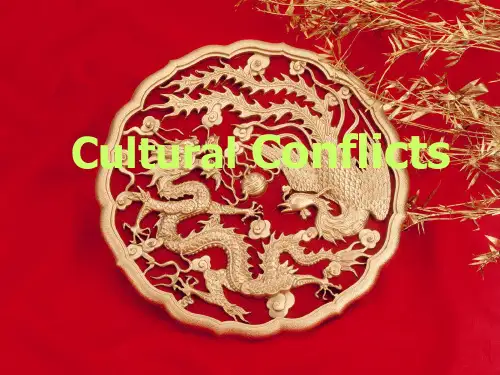
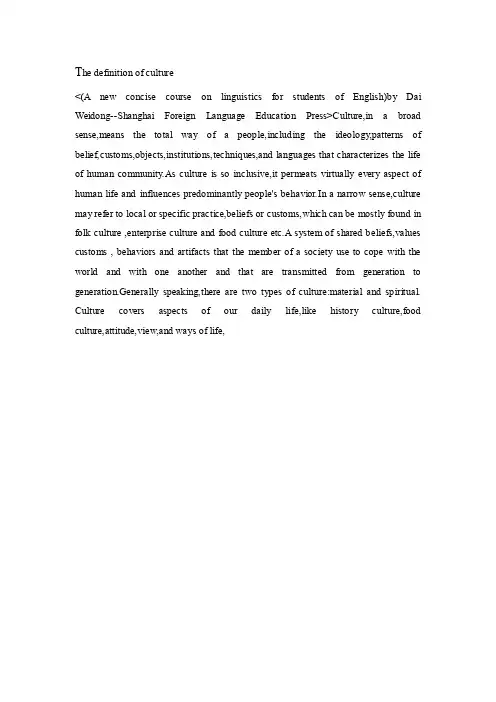
T he definition of culture<(A new concise course on linguistics for students of English)by Dai Weidong--Shanghai Foreign Language Education Press>Culture,in a broad sense,means the total way of a people,including the ideology,patterns of belief,customs,objects,institutions,techniques,and languages that characterizes the life of human community.As culture is so inclusive,it permeats virtually every aspect of human life and influences predominantly people's behavior.In a narrow sense,culture may refer to local or specific practice,beliefs or customs,which can be mostly found in folk culture ,enterprise culture and food culture etc.A system of shared beliefs,values customs , behaviors and artifacts that the member of a society use to cope with the world and with one another and that are transmitted from generation to generation.Generally speaking,there are two types of culture:material and spiritual. Culture covers aspects of our daily life,like history culture,food culture,attitude,view,and ways of life,The definition of culture differenceCulture difference refers to different response or expression made by people belong to two or more geographical areas,nations when it comes to the similar thing or one same object.As the representative of eastern culture and western culture,China and America both have formed their own systematical cultures.When people from tw9o different countries communicate with each other ,differences in ideology,patterns of belief,customs,objects,institutions,techniques appear.Festival is a very significant part of culture.The traditional festivals deposit each country's long history and culture ,and they are the important carriers of a nation's culture.We can learn detailed cultural differences in belief,food habits,value,and color psychology through comparing the traditional festivals of the two cultures. In this essay ,we will talk about the different ways of celebrating festivals which are of the same importance to China ,symbolizing eastern culture and to America,symbol of western culture.We will also talk about origins ,customs,main characteristics about these festivals.The definition of festival<Oxford Advanced Learner's Dictionary>A day or period of the year when people stop working to celebrate a specific event ,often a religious one .In China,people universally celebrate the Spring Festival,Dragon Boat Festival,Mid-autumn Festival and Tomb-sweeping day and so on.In western countries,people celebrate Christmas,Easter,V alentine's Day,and Halloween,Thanksgiving Day.Outline:1. Introduction1.1 Significance and purpose of the essay1.2 The foreign situation of the research1.3 The domestic situation of the research2.Definition2.1Definition of culture2.2Definition of cultural difference2.3Definition of festival ,traditional festivals of China and Western countries3.Cultural differences3.1Cultural difference in value3.2Cultural difference in belief3.3Cultural difference in food habits3.3Cultural difference in color phychology4.ConclusionCulture is composed of many items like history , ideology,value,belief ,and food habits。

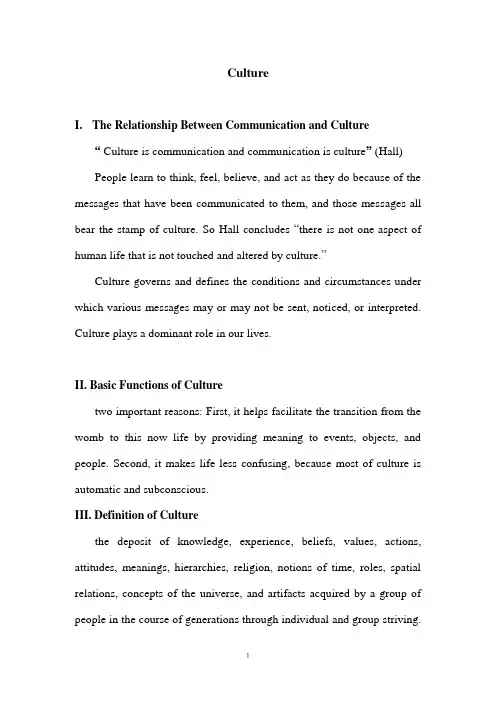
CultureI.The Relationship Between Communication and Culture“Culture is communication and communication is culture”(Hall)People learn to think, feel, believe, and act as they do because of the messages that have been communicated to them, and those messages all bear the stamp of culture. So Hall concludes “there is not one aspect of human life that is not touched and altered by culture.”Culture governs and defines the conditions and circumstances under which various messages may or may not be sent, noticed, or interpreted. Culture plays a dominant role in our lives.II. Basic Functions of Culturetwo important reasons: First, it helps facilitate the transition from the womb to this now life by providing meaning to events, objects, and people. Second, it makes life less confusing, because most of culture is automatic and subconscious.III. Definition of Culturethe deposit of knowledge, experience, beliefs, values, actions, attitudes, meanings, hierarchies, religion, notions of time, roles, spatial relations, concepts of the universe, and artifacts acquired by a group of people in the course of generations through individual and group striving.Views on … are part of your cultural membership.IV. Characteristics of Culture1. Culture is learned.From infancy, members of a culture learn their patterns of behavior and ways of thinking until most of them become internalized and habitual.1)We learn our culture through proverbs.2)We learn our culture from folk tales, legends, and myths.3)We learn our culture through art.4)We learn our culture through mass media.2. Culture is Transmitted from Generation to GenerationCulture and communication are linked : communication makes culture a continuous process, for once cultural habits, principles, values, attitudes, and the like are “formulated,” they are communicated to each member of the culture.3. Culture is Based on Symbols.The emergence of language was the giant step that made culture possible.symbols: the spoken words; the written words; nonverbal actions….4. Culture is Subject to ChangeCultures are dynamic system, so they are subject to change.Cultures are constantly being confronted with ideas and information from outside sources, and contact brings change.Although many aspects of culture are subject to change, the deep structure of a culture resists major alteration.5. Culture is Integrated.Culture functions as an integrated whole—it is, like communication, systemic. That is, culture functions as an interrelated whole.“You touch a culture in one place and everything else is affected.”6. Culture is EthnocentricEthnocentrism is “the technical name for the view of things one’s own group is the center of everything. This propensity to see things from our own cultural viewpoint is very natural and, unless carried to an extreme, can have positive effects.For example, ethnocentrism is often “a source of cultural and personal identity.”7. Culture is AdaptivePeople can make adaptations to cultural changes.V. Intercultural Communication1.Definition:Intercultural communication is communication between peoplewhose cultural perceptions and symbol systems are distinct enough to alter the communication event.2. Forms of Intercultural Communication.1)Interracial communication2)Interethnic communication3)Intracultural communication3.Elements of Intercultural CommunicationPerceptionCultural perceptions are based on beliefs, values, and attitude systems.verbal processes: how we talk to each other and think.。
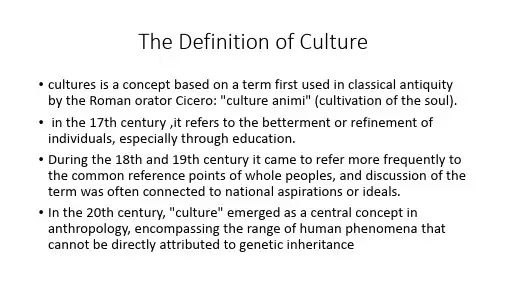
Culture➢文化的定义The Definition of Culture1、Taylor:Culture is the complex whole which includes knowledge, belief, art, morals, law, custom and any other capabilities and habits acquired by man as a member of society.(文化是一个复合的整体,包括知识、信仰、艺术、道德、法律、风俗,以及人类在社会里所获得的一切能力与习惯。
)2、Culture is the way of the members of a society to lead their lives. ➢文化的元素The Elements of Culture1、History2、Language3、Norms4、Value5、Religion and beliefs6、Social Collectives7、Status and roles 8、Culture integrationA Brief History of China中国历史的四个阶段Chinese history can be divided into 4 periods: •The Legendary Period传说时期•The Ancient Period古代•The Modern Period近代•Contemporary Period现代The Three Sovereigns(三皇):FuXi 伏羲 Yandi 炎帝 Huangdi 黄帝Five Emperors(五帝):Shaohao(少昊) Zhuanxu(颛顼) Diku(帝喾) Yao (尧) Shun(舜)Descendants of Yandi and Huangdi(炎黄子孙)Huaxia nationality(华夏民族)Non-Hereditary system(禅让制)北京人Peking Man的特点:They could walk upright, make and use simple tools, and make use of fire.Matriarchal society (母系氏族)Patriarchal society(父系氏族)Oracle bone 甲骨文Mandate of the Heaven 天命Son of the Heaven 天子100 schools of thought百家争鸣Seven Great Powers (战国七雄):齐、楚、燕、韩、赵、魏、秦The Art of War《孙子兵法》The period of Great Feudal Unity:The Qin and Han Dynasties封建大一统时期——秦汉:•Centralized government中央集权政府•The first feudal empire第一位封建帝王•Standardization of weights, measures, coinage, writing systems and legal codes统一度量衡、书同文、统一法律•秦始皇的贡献:He unified the Language, the measurement system and the currency, set up the prefectures and counties system, constructed the famous Great Wall and built extravagant palaces and mausoleums.The division of China once more and the intermingling of ethnic groups 封建国家的分裂和民族大融合Romance of the Three Kingdoms《三国演义》The Destruction of Opium at Humen虎门销烟The May 4th Movement五四运动Land and People➢中国的邻国China borders on 14 countries:North Korea, Russia, Mongolia, Kazakhstan, Kyrgyzstan, Tajikistan Afghanistan, Pakistan, India, Nepal, Bhutan, Myanmar/Burma, Laos, and Vietnam 朝鲜、俄罗斯、蒙古、哈萨克斯坦、吉尔吉斯斯坦、塔吉克斯坦、阿富汗、巴基斯坦、印度、尼泊尔、不丹、缅甸、老挝、越南➢中国地理特征1、China is a country of varied topographical features with highlands in the west and plains in the east.2、Tak ing a bird’s-eye view of China,the terrain descends from the west to east like a four-staircase.The roof of the world世界屋脊Qinghai-Tibet Plateau青藏高原➢中国气候1、Most parts of China are in the north temperate zone.2、Parts of the southern area are in the tropical or subtropical zone.3、Parts of the northern area are in the frigid zone.4、Continental monsoon climate in China大陆性季风气候:1) cold and dry winters;2) warm and humid summers.➢中国政体Chinese Regime•The Constitution of the People’s Republic of China is the fundamental law of the state.•The NPC is the highest organ of state power.•The Communist Party is the sole party in power in China. Apart from it, there are eight democratic parties in China.•The State Council, or the Central People’s Government, of the People’s Republic of China is the executive body of the highest organ of state power and the highest organ of state administration.(填空/简答)Gross domestic product(GDP), the total market value of allthe goods and services produced in a country in a specific period. Economic reform and opening-up(改革开放) are the two fundamental State policies of China.(填空/简答)One Child Policy(独生子女政策):It is a policy of family planning, hoping to control the population increase, improve population quality.➢中国人普遍观念——四代同堂Four generations under one roof:1)Large family units vs. Smaller family units.2)Valued sons far more than daughters vs. Girls as well as boys are valued.3)Wives stayed home to do homework, cook and attend to the children-----Women do many kinds of work outside the home.➢民族政策:Equality, unity, mutual help and common prosperity (平等,团结,互助,共同繁荣)are the basic principles of the Chinese government in handing the relations between ethnic groups.➢Living together in one area while still living in individual compact communities in special areas 大杂居,小聚居Chinese Philosophy➢Factors contribute to a Chinese-characterized philosophy:1、Ancient China is an inland country.2、Rulers of each dynasty attached increasing importance toagriculture rather than commerce.3、Kinship is highly valued➢The Characters of Chinese philosophy:1、Practical both individually and politically.2、View all universal beings as an integrated.3、Emphasizes a dialectical way of between opposite forces.4、Concepts are ambiguous(模糊不清的).➢儒学(Confucianism)分为经典儒学(The Classical Confucianism)和宋明理学(Neo-Confucianism)➢经典儒学的历史:It was forbidden in the Qin DynastyIt was proclaimed the national curriculum and became a requirement for the application for a government post in the Han Dynasty period bitter physical and mental sufferings of the masses promoted the flourish of religious Buddhism, Confucianism again became an official philosophy in the Tang Dynasty,an Imperial Examination based on Confucianism was set up aiming to choose talents to serve in state government.It was inevitable that there would be a revival of Confucianism. ➢经典儒学代表人物:ConfuciusMenciusXun Zi➢Confucius’s Idea s:1、Confucius’ primary concern lay in social relations, proper conductand social harmony.2、Confucius did not create new things, but handed down old but soundknowledge and customs.3、Confucius compiled and preserved many literary works of ancienttimes, including The Book of Songs, The Book of Documents and The Book of Changes.(《诗经》《尚书》《易书》)➢经典儒学主要观点:The Rectification of Name 正名(荀子的思想核心)Rule right by virtue 德政Humanity 仁Ritual and Harmony 礼、和To Recognize the Mandate of Heaven 知天命➢(翻译):政者,正也,子率以正,孰敢不正!To govern means to rectify. If you,sir, will lead in therectification ,who will dare not to be rectified?➢(翻译):仁者爱人推己及人。
文化、跨文化交际、文化价值观的定义Definitions of CultureCulture is learned and shared within social groups and istransmitted from one generation to another for purposes of promoting individual and social survival, adaption, and growth and development. Generally speaking, culture means both human and society that have developed to a certain level in history. It consists of all forms of human lives and activities, and all the man-made material and spiritual wealth. Specifically speaking, it solely means “areas of man’ssp iritual life”. Cultureis created by man; it also continually creates human beings, countries, nations, personal characters, psychologies, behaviors, ways of thinking and various values.According to Samovar and Porter (2010), culture refers to the cumulative deposit of knowledge, experience, beliefs, values, attitudes, meanings, hierarchies, religion, notions of time, roles, spatial relations, concepts of the universe, and material objects and possessions acquired by a group of people in the course of generations through individual and group striving.Definitions of Intercultural CommunicationIntercultural communication occurs when a member of one culture produces a message for consumption by a number of another culture. More precisely, intercultural communication involves interaction betweenpeople whose cultural perception and symbol systems are distinct enough to alter the communication event.Intercultural communication in its most basic form refers to an academic field of study and research. It seeks to understand how people from different countries and cultures behave, communicate and perceive the world around them. The definition of intercultural communication must also include strands of the field that contribute to it such as anthropology, cultural studies, psychology and communication.According to the definition from Wikipedia, the free encyclopedia, intercultural communication is a form of global communication. It is used to describe the wide range of communication problems that naturally appear within an organization made up of individuals from different religious, social, ethnic, and educational backgrounds.Karlfried Knapp (1987) defines it as the interpersonal interaction between members of different groups, which differ from each other in respect of the knowledge shared by their members and in respect of their linguistic forms of symbolic behavior.”Definitions of Cultural ValueCultural values are values that tend to permeate a culture. They are the goodness or desirability of certain actions or attitudes among members of the culture. They are transmitted by a variety of sources (family, media, school, church, state, and so on) and therefore tend to be broad-based, enduring, and relatively stable. They guide bothperception and communication. That is, values get translated into action. An understanding of cultural values helps us appreciate the behavior of other people, knowing, for instance, that the American value of directness and the exchange of eye-contact, might cause us to apply one trick of focusing in the space between the eyebrows, and “faking it” until we can make eye contact ourselves. What is more, an awareness of cultural values also helps us understand our own behavior. For example, we can associate patience with the value of time, moderation with the value of harmony and consensus, and obligation with the twin value of friendship and sociability.Hu Wenzhong (1999), a famous cultural scholar in China, has pointed out that of all the problems discussed or studied in intercultural communication research, value is one of the most important problems and deserves great attention. Values come from social life and provide criteria for behavior. “They prescribe which actions and ways of being are better than others;they are not descriptions of fact,but possess contentand emotion and contribute to social reality.” Scholars haveoffered many versions ofdefinitions for values.。
在线作业1.0第1题 When you talk with your friends aboutPicasso, Beethoven, you are talking about culturefrom ______ perspective.您的答案:B题目分数:0.5此题得分:0.5批注:Definitions of Culture第2题 ______ refer to rules for appropriatebehavior, which provide the expectations peoplehave of one another and of others.您的答案:C题目分数:0.5此题得分:0.5批注:Definitions of Culture第3题 ______ is considered the father ofIntercultural communication.您的答案:A题目分数:0.5此题得分:0.5批注:introduction to intercultural communication study第4题 The publication of Hall' s marked thebeginning of Intercultural communication study.您的答案:D题目分数:0.5此题得分:0.5批注:introduction to intercultural communication study第5题 Culture is defined as " the software ofmind" by您的答案:B题目分数:0.5此题得分:0.5批注:Definitions of Culture第6题 Culture is a learned set of sharedinterpretations about beliefs, values, and normswhich affect the behavior of a relatively large group. This is the definition of culture from perspective.您的答案:C题目分数:0.5此题得分:0.5批注:Definitions of Culture第7题 Culture is like an iceburg. It is said that of culture is visible, that is above the waterline.您的答案:D题目分数:0.5此题得分:0.5批注:Metaphor of culture第8题 is the belief that your own cultural background, including ways of analyzing, problems, values, beliefs, language, etc. is superior.您的答案:B题目分数:0.5此题得分:0.5批注:Characteristics of Culture第9题 Culture comes in layers, like an onion. On the outer layer are您的答案:D题目分数:0.5此题得分:0.5批注:Metaphor of culture第10题 are social principles, goals, or standards accepted by persons in a culture.您的答案:C题目分数:0.5此题得分:0.5批注:Metaphor of culture第11题?____ is the process of putting an ideainto a symbol.您的答案:B题目分数:0.5此题得分:0.5批注:Components of communication第12题 _____ refers to anything that distorts the message the source encodes.您的答案:A题目分数:0.5此题得分:0.5批注:Components of communication第13题?ommunication does not occur in isolation or in a vacuum, but rather it takes place in a physical and a social context; both establish the rules that govern the interaction. It reflects _____.您的答案:D题目分数:0.5此题得分:0.5批注:Characteristics of Communication第14题?In China, if a Tibetan communicates with a Han, it is _____.您的答案:A题目分数:0.5此题得分:0.5批注:Other types of Communication第15题 _____ refers to the communication within and between businesses that involve people from more than one culture您的答案:C题目分数:0.5此题得分:0.5批注:Definition of intercultural business communication第16题 _____ refers to communication between people whose cultural perceptions and symbolsystems are distinct enough to alter the communication event.您的答案:A题目分数:0.5此题得分:0.5批注:Definition of intercultural communication第17题 refers to extended meanings or associated meanings.您的答案:B题目分数:0.5此题得分:0.5批注:Word Meaning and Culture第18题 Which of the following words has the same connotational meaning and denotational meaning in both Chinese and English?您的答案:A题目分数:0.5此题得分:0.5批注:Word Meaning and Culture第19题 A common form of interdepartmental communication in business is .您的答案:D题目分数:0.5此题得分:0.5批注:Written Communication第20题 is the communication by means of written symbols, either printed or handwritten.您的答案:B题目分数:0.5此题得分:0.5批注:Written communication第21题 Culture cannot be known without a study of communication, and communication can only be understood with an understanding of the culture it supports.题目分数:0.5此题得分:0.5批注:relationship of culture and communication第22题 Stereotypes, like culture itself, are learned in a variety of ways. They are the products of limited, lazy, and misguided perceptions.您的答案:正确题目分数:0.5此题得分:0.5批注:communication barriers第23题 Verbal communication is the transferring of thoughts between individuals only via spoken messages.您的答案:错误题目分数:0.5此题得分:0.5批注:definition of verbal communication第24题 In the global village, neighbors communicate free of troubles and difficulties.您的答案:错误题目分数:0.5此题得分:0.5批注:communication barriers第25题 The culture shown in an onion consists of two levels: an invisible level and a visible level.您的答案:错误题目分数:0.5此题得分:0.5批注:metaphors of culture第26题 Culture is all men' s medium;there is no aspect of human life that is not touched and altered by culture.题目分数:0.5此题得分:0.5批注:characteristics of culture第27题 Language and culture are closely related, reflecting, influencing and shaping each other.您的答案:正确题目分数:0.5此题得分:0.5批注:relationship of culture and language第28题 Verbal communication is not as clarified and efficient as other ways of communication, e.g. written communication.您的答案:错误题目分数:0.5此题得分:0.5批注:Attributes of Verbal Communication第29题In America, there is a saying “good fences make good neighbors” revealing that American people tend to keep a safe distance from each other.您的答案:正确题目分数:0.5此题得分:0.5批注:Ways of greeting第30题 Connotation meaning of a word means a dictionary definition.您的答案:错误题目分数:0.5此题得分:0.5批注:Word Meaning and Culture第31题 The invisible part of culture iceburg is also called the hidden culture, including norms, values, assumptions.您的答案:正确题目分数:0.5此题得分:0.5批注:metaphors of culture第32题 Culture is learned, not inherited. It derives from one’s social environment, not from one’s genes.您的答案:正确题目分数:0.5此题得分:0.5批注:characteristics of culture第33题 Members from different cultures share the same set of ideals, values and standards of behaviors. This shows that culture is shared.您的答案:错误题目分数:0.5此题得分:0.5批注:characteristics of culture第34题 Culture is subject to change, constantly changing.您的答案:正确题目分数:0.5此题得分:0.5批注:characteristics of culture第35题 Communication can take place in a vacuum even without a specific setting or context.您的答案:错误题目分数:0.5此题得分:0.5批注:characteristics of communication第36题 Context refers to the means by which the encoded message is transmitted.您的答案:错误题目分数:0.5此题得分:0.5批注:Components of communication第37题 In English, red is usually associatedwith something undesirable您的答案:正确题目分数:0.5此题得分:0.5批注:Word Meaning and Culture第38题“Let‘s get together sometimes thisweek, I will call you.” If an American says thisto you, this can be regarded as a real invitation.您的答案:错误题目分数:0.5此题得分:0.5批注:How to invite others第39题 In conversation with westerners,neverask questions related to privacy, such as age,money, marriage, health, and family.您的答案:正确题目分数:0.5此题得分:0.5批注:How to chat with others第40题 Being modest is also one of thetraditional virtues of western people.您的答案:错误题目分数:0.5此题得分:0.5批注:Being modest作业总得分:20.0作业总批注:在线作业2.0第1题 _______ means that nonverbal behavior cansupport, but could not replace the verbalmessage.您的答案:D题目分数:0.5此题得分:0.5批注:function of nonverbal communication第2题 Some researchers maintain that inface-to-face communication up to 93 percent of an oral message is communicated .您的答案:B题目分数:0.5此题得分:0.5批注:Importance of nonverbal communication第3题 Which of the following country does not like direct eye contact?您的答案:C题目分数:0.5此题得分:0.5批注:eye contact第4题 Which of the following country like intense eye contact most?您的答案:A题目分数:0.5此题得分:0.5批注:eye contact第5题 Which of the following country has the closest personal space?您的答案:D题目分数:0.5此题得分:0.5批注:Space第6题 Which of the following country belongs to contact culture?您的答案:D题目分数:0.5此题得分:0.5批注:touch第7题 Which of the following country belongs to low-contact culture?您的答案:A题目分数:0.5此题得分:0.5批注:touch第8题 Which of the following country uses silence a lot during communication?您的答案:B题目分数:0.5此题得分:0.5批注:silence第9题 Which of the following country belongs to monochronic culture?您的答案:C题目分数:0.5此题得分:0.5批注:Time第10题 Which of the following country belongs to polychronic culture?您的答案:D题目分数:0.5此题得分:0.5批注:Time第11题is the innermost “skin of the onion” and lies at the core of a culture.您的答案:C题目分数:0.5此题得分:0.5批注:definition of value第12题 When nonverbal and verbal messages appear inconsistent, most of us tend to believe verbal messages.您的答案:错误题目分数:0.5此题得分:0.5批注:Importance of nonverbal communication第13题 In Western cultures eye contact can signify honesty, whereas in Asian cultures it may indicate rudeness.您的答案:正确题目分数:0.5此题得分:0.5批注:eye contact第14题 People from different social classes within one culture also may use nonverbal signals differently.您的答案:正确题目分数:0.5此题得分:0.5批注:factors influencing noverbal communication第15题 Latin and Arab cultures use more subdued facial expressions, whereas East Asian cultures use more intense facial expressions.您的答案:错误题目分数:0.5此题得分:0.5批注:facial expression第16题 Personal territory can be large or small, which is much related to certain elements such as place, sex, age and character.您的答案:正确题目分数:0.5此题得分:0.5批注:space第17题 Postures send same messages to all people, e.g. when you stand in an upright position, you impress others as being energetic.您的答案:错误题目分数:0.5此题得分:0.5批注:posture第18题 The British, like Americans, believe that looking someone directly in the eye is a mark of rudeness until a more intimate relationship is established.您的答案:错误题目分数:0.5此题得分:0.5批注:eye contact第19题 Nonverbal codes play an important part in communication or intercultural communication. But it is not as important as verbal codes.您的答案:错误题目分数:0.5此题得分:0.5批注:Importance of nonverbal communication第20题 We put the index finger and mid-finger apart with palm against the receiver to mean “OK”, which was first used by Winston Churchill.您的答案:错误题目分数:0.5此题得分:0.5批注:gestures第21题 How closely people position themselves to one another during a discussion or talk cannot communicate what type of relationship exists between them.您的答案:错误题目分数:0.5此题得分:0.5批注:space第22题 Where uncertainty avoidance is high, the society is concerned with certainty and security.您的答案:正确题目分数:0.5此题得分:0.5批注:uncertainty avoidance第23题 In feminine societies, men and women are considered socially unequal.您的答案:错误题目分数:0.5此题得分:0.5批注:masculinity versus femininity第24题 Individualists prefer self-sufficiency while collectivists give more recognition to their interdependent roles and obligations to the group.您的答案:正确题目分数:0.5此题得分:0.5批注:individulaism versus collectivism第25题 Where power distance is large, the society believes that there should be awell-defined order of inequality in which everyone has a rightful place.您的答案:正确题目分数:0.5此题得分:0.5批注:power distance第26题 Asian, Latin American, and West African nations are societies high in individualism but low in collectivism.您的答案:错误题目分数:0.5此题得分:0.5批注:individulaism versus collectivism第27题 In high masculinity societies, people tend to believe that matters of material comfort, social privilege, etc. are related to ability.您的答案:正确题目分数:0.5此题得分:0.5批注:masculinity versus femininity第28题 Large power distance countries such as the United States, Austria, Finland, and Denmark hold that inequality in society should be minimized.您的答案:错误题目分数:0.5此题得分:0.5批注:power distance第29题 In high-context culture, that of North America, for example, a large portion of the message is left unspecified and accessed through the context.您的答案:错误题目分数:0.5此题得分:0.5批注:high-context versus low-context culture第30题 In low-context cultures, people judge what someone is talking about not only by what he is saying but also by the context in which the message occurs.您的答案:错误题目分数:0.5此题得分:0.5批注:high-context versus low-context culture第31题 In high-context communication the listener is already contexted and so does not need to be given much background information.您的答案:正确题目分数:0.5此题得分:0.5批注:high-context versus low-context culture在线作业3.0第1题 Liming, a Chinese student, just began hisstudy in a university in the United States. In hisfirst week in U.S, he thought everything was newand exciting, and he enjoyed himself a lot. Limingis in_____ stage of culture shock.您的答案:A题目分数:0.5此题得分:0.5批注:Stages of Culture Shock第2题 An American company that operates in Japanalmost caused a disaster in the UnitedStates—Japanese relations by addressing 500 redChristmas cards to its Japanese joint-venturepartner, since funeral notices are red in Japan.This case has reflected that each country has itsart for _____.您的答案:D题目分数:0.5此题得分:0.5批注:Business etiquette and social custom第3题 _________ ?efers to the traumaticexperience that an individual may encounter whenentering a different society.您的答案:C题目分数:0.5此题得分:0.5批注:Business etiquette and social custom第4题?_____is the traditional way of greetingin Northeast Asian countries like Korea andJapan.您的答案:A题目分数:0.5此题得分:0.5批注:Business etiquette and social custom第5题 _____refers to manners and behaviorsconsidered acceptable in social and businesssituation.您的答案:B题目分数:0.5此题得分:0.5批注:Business etiquette and social custom第6题 _____refers to practices or verbal expressions considered by a society or culture as improper or unacceptable.您的答案:B题目分数:0.5此题得分:0.5批注:Business etiquette and social custom第7题 ________ refers to a discussion between two or more disputants who are trying to work out a solution to their problem.您的答案:D题目分数:0.5此题得分:0.5批注:intercultural negotiation第8题 _______ refers to a working knowledge of the cultural variables affecting management decisions.您的答案:C题目分数:0.5此题得分:0.5批注:intercultural management第9题 Which of the following is the psychological symptom of culture shock?您的答案:A题目分数:0.5此题得分:0.5批注:Symptoms of culture shock第10题 Which of the following is the physical symptom of culture shock?您的答案:D题目分数:0.5此题得分:0.5批注:Symptoms of culture shock第11题 In _______ stage, there may be feelings of discontent, impatience, anger, sadness, and feeling of incompetence.您的答案:B题目分数:0.5此题得分:0.5批注:Stages of Culture Shock第12题 In _______ stage, one may gian some understanding of the new culture and a new feeling of pleasure and sense of humor may be experienced.您的答案:C题目分数:0.5此题得分:0.5批注:Stages of Culture Shock第13题 In _______ stage, one may realize that the new culture has good and bad things to offer and acuqire a more solid feeling of belonging.您的答案:D题目分数:0.5此题得分:0.5批注:Stages of Culture Shock第14题 Which people in the following country tend to have a soft handshaking?您的答案:A题目分数:0.5此题得分:0.5批注:handshaking第15题 In which of the the following country age and hierarchy are umimportant?您的答案:D题目分数:0.5此题得分:0.5批注:position and status第16题 Which people in the following country tend to have smalltalk with business partners?您的答案:B题目分数:0.5此题得分:0.5批注:Small talk第17题 Which people in the following country tend to give and accept tips?您的答案:C题目分数:0.5此题得分:0.5批注:tipping第18题 Which of the following is not suitable as a business gift choice in America?您的答案:D题目分数:0.5此题得分:0.5批注:gift-giving第19题 In which of the following country developing trust is an important first step to any business transaction?您的答案:D题目分数:0.5此题得分:0.5批注:Intercultural Negotiation第20题 In which of the following culture prestigious products and brands find lucrative markets?您的答案:B题目分数:0.5此题得分:0.5批注:intercultural marketing第21题 Cultural shock is the trauma youexperience when you move into a culture different from your home culture.您的答案:正确题目分数:0.5此题得分:0.5批注:Definition of culture shock第22题 The easier it is to adjust to a new culture, the easier it is to readjust to home culture.您的答案:错误题目分数:0.5此题得分:0.5批注:reverse culture shock第23题 For some multinational firms, they can alleviate culture shock by selecting employees for overseas assignments who possess certain personal and professional qualifications.您的答案:正确题目分数:0.5此题得分:0.5批注:alleviating culure shock第24题 People will experience culture shock exactly the same way and go through the stages of cultural adjustment in the same order.您的答案:错误题目分数:0.5此题得分:0.5批注:stages of culture shock第25题 Biculturality means total conversion period, in which people have become comfortable in both the old and the new culture.您的答案:错误题目分数:0.5此题得分:0.5批注:stages of culture shock第26题 People often find reverse culture shock more surprising and difficult to deal with than the original culture shock.您的答案:正确题目分数:0.5此题得分:0.5批注:reverse culture shock第27题 In Europe, people hold the fork in the left hand and the knife in the right hand throughout a meal.您的答案:正确题目分数:0.5此题得分:0.5批注:dining practice第28题 The goal at a cocktail party is to meet as many people as possible. Everyone expects to get into deep discussions.您的答案:错误题目分数:0.5此题得分:0.5批注:dining practice第29题 In Europe and North America, business cards are far less formalize and are used merely to keep track of who’s who during a hectic meeting schedule.您的答案:正确题目分数:0.5此题得分:0.5批注:exchanging business cards第30题 Some business people maintain that American humor is helpful to export and appreciate.您的答案:错误题目分数:0.5此题得分:0.5批注:humor in business第31题 American negotiators tend to be competitive in their approach to negotiation and like to bargain from a position of strength.您的答案:正确题目分数:0.5此题得分:0.5批注:American negotiators第32题 German businessmen have serious principles about interpersonal relationship and they focus on personal credit.您的答案:正确题目分数:0.5此题得分:0.5批注:German negotiators第33题 In Asian cultures, signed agreements are far less important than keeping the interdependent, interwoven organizations involved in a good relationship.您的答案:正确题目分数:0.5此题得分:0.5批注:Asian negotiators第34题 Gifts in the Japan are opened in front of the giver, admired, and thanks are expressed orally and in writing.您的答案:错误题目分数:0.5此题得分:0.5批注:gift-giving practice第35题 Superstitions are practices or verbal expressions considered by a society or culture as improper or unacceptable.您的答案:错误题目分数:0.5此题得分:0.5批注:taboo第36题 In Arab countries, it is considered taboo to ask about the health of a man’s wife.您的答案:正确题目分数:0.5此题得分:0.5批注:taboo第37题 The architecture and decor of the office building, what people wear, the overall environment of the company are part of corporate culture.您的答案:正确题目分数:0.5此题得分:0.5批注:corporate culture第38题 Culture differences can generate positive impacts on negotiation as people can learn from each other.您的答案:错误题目分数:0.5此题得分:0.5批注:culture and negotiation第39题 Culture defines acceptable purchasing and product-use behavior for both consumers and business.您的答案:正确题目分数:0.5此题得分:0.5批注:intercultural marketing第40题 A successful marketing approach in one country will automatically work in another country.您的答案:错误题目分数:0.5此题得分:0.5批注:intercultural marketing。
Chapter11.The nature of Culture:(1)C ulture is like an iceberg (2) Culture is our software (3)Culture is like the water a fish swims in (4) Culture is the grammar of our behavior2.The definition of cultureCulture is the deposit of knowledge, experience, beliefs, values, actions, attitudes, hierarchies, religions, notions of time, role, spatial relations, concepts of the universe, and artifacts acquired by a group of people in the course of generations through individual and group striving.3.The definition of subculturesSubcultures exist within dominant culture, and are often based on economic or social class, ethnicity, race, or geographic region. 4.Scholars of different fields defined culture from their ownperspectivesAnthropological perspective, psychological perspective, sociological perspective, intercultural perspective, etc.5.Our definition of cultureWe define culture as the deposit of knowledge, experience, beliefs, values, actions, attitudes, hierarchies, religions, notions oftime, roles, spatial relations, concepts of the universe, and artifacts acquired by a group of people in the course of generations through individual and group striving.6.Characteristics of culture(1)c ulture is learned (2) culture is dynamic (3) culture ispervasive (4) culture is integrated (5) culture is adaptive(1)c ulture is learned:a. We learn our culture through proverbsb. We learn our culture from folklorec. We learn our culturethrough art d. We learn our culture through mass media7. Culture identity defined:Culture identity refers to one’s sense of belonging to a particular culture or ethnic group. People consciously identify themselves with a group that has a shared system of symbols and meanings as well as norms for conduct.8.Formation of culture identitya.unexamined culture identityb.culture identity searchc.culture identity achievement9.Characteristics of culture identityCulture identity is central to a person’s sense of selfCulture identity is dynamic, and one’s culture identityCulture identity is also multifaceted components of theirself-concept.10.the definition of subcultureSubcultures exist within dominant culture, and often based on economic or social class, ethnicity, race, or geographic region.ponents of communicationa.sender/sourceb. messagec. encodingd. channele. receiverf.decoding g. feedback h. noise12.In western culture, communication is studied as the means oftransmitting ideas. Western cultures emphasize the instrumental function of communication; that is, effectiveness is evaluated in terms of success in the manipulation of others to achieve one’s personal goal.13.the components of noisea. external noise(外界干扰)b. physiological noise(生理干扰)c.psychological noise(心理干扰)d. semantic noise(语义干扰)14. the components of contexta. the physical contextb. the social contextc. the interpersonal context.15. What is the relationship between culture and communication? culture inherently(天性的,固有的) contain communication systems. Communication and culture are inseparable. A. cultures generate symbols, rituals(宗教习惯),customs, and formats.16. How does culture affect its communication style?Each culture encourages a particular communication style expected within it. This implies not only using correct symbols, but also applying the appropriate communication style for the occasion.17. The definition of intercultural communicationMore precisely intercultural communication is communication between people whose cultural perception and symbol system are distinct enough to alter the communication event.18. Forms of intercultural communicationa. international communicationb. interracial communicationc.interethnic communication d. intracultural(同一文化内的) communication19. the definition of anxiety and uncertaintya. anxiety occurs because of not knowing what one is expected to do, and focusing on that feeling and not being totally present in the communication transaction(事务).b. uncertainty refers to our cognitive inability to explain our own or others’feelings and behaviors in interactions because of an ambiguous(含糊的,模棱两可的) situation that evokes anxiety.20. Strategies to overcome anxiety and uncertaintyA. we directly gather information through verbal interrogation(询问) or by asking our counterparts questions about themselves.B. we open ourselves to our counterparts (极其相似的人) by disclosing personal information that they do not know.21. Assuming similarity instead of difference(假定相似性代替差异性)重点考案例分析The second barrier is assuming similarity instead of difference. It refers to the idea that people coming from another culture are more similar to you than actually are or that another person’s situation is more similar to yours than it in fact is.(假定一致性是指认为来自另一文化的他人和自己相似或他人的处境相似,而事实上却并非如此).22. The definition of ethnocentrism (民族中心主义)。